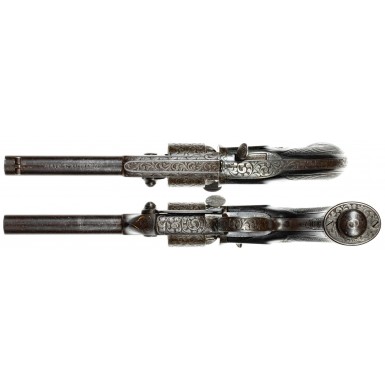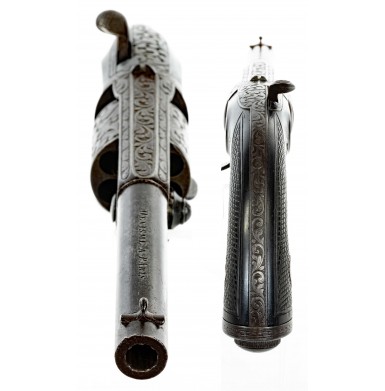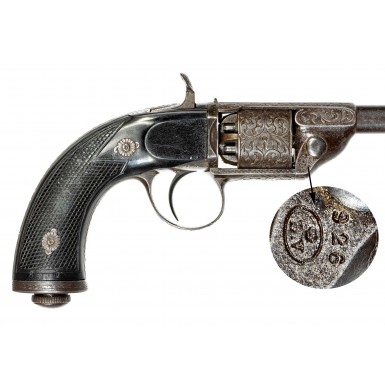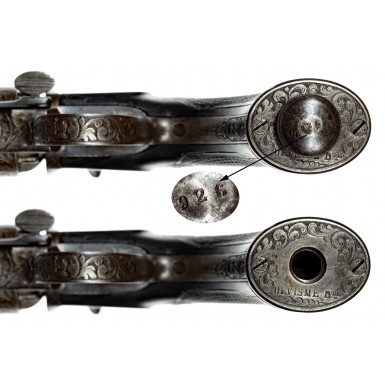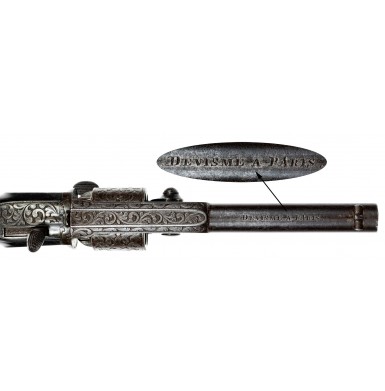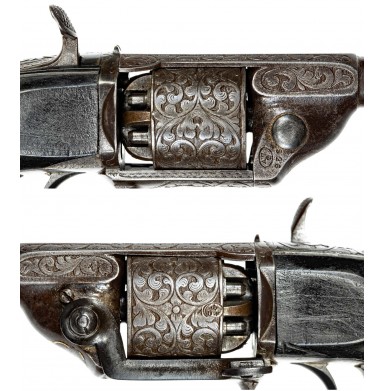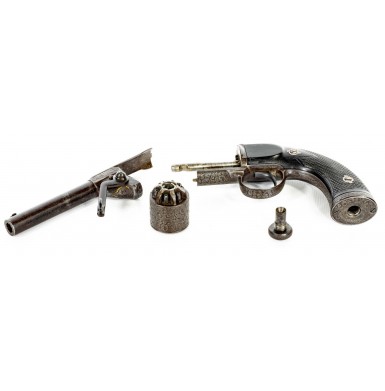Engraved Devisme M1854/55 Pocket Percussion Revolver
- Product Code: FHG-2190-SOLD
- Availability: Out Of Stock
-
$2,250.00
The firearms produced by Louis-François Devisme (pronounced div-eem) of Paris are among the most highly sought after and desirable arms manufactured during the 19th century. Devisme was an incredibly talented French gunsmith and inventor whose talent and fine aesthetic sense allowed him to produce firearms and swords that were truly works of art. Devisme was born in Paris in 1806 (some sources list his birth date as 1804) and before the age of 30 he had received his first award for firearms design and manufacture at the 1834 Paris Exhibition of Industry. Over the next three decades, Devisme and his son would receive numerous awards and medals for the firearms that he displayed at numerous French Exhibitions, including silver medals in 1839 & 1841 and additional awards in 1855, 1862 and 1867. He also received a medal at the Great Exhibition of 1851 in London (also known as the Crystal Palace Exhibition) for firearms that he displayed there. It is likely that Samuel Colt first became aware of Devisme’s work at The Crystal Palace Exhibition and Colt was apparently impressed enough that he acquired one of Devisme’s percussion revolvers (in unfinished form) for the Colt firearms collection. The pocket-sized percussion revolver of about .28 caliber is well documented in Colt company records, and the gun (serial #1485) no doubt served as a study piece for Colt and his other designers as well. Devisme manufactured a wide array of firearms from sporting arms like rifles and shotguns to innovative revolvers, single shot pistols and even a “Flobert” type parlor pistol. He introduced a very advanced centerfire revolver in 1858-59, based upon an earlier percussion design and in doing so manufactured one of the first (if not the first) “striker fired” handguns, a concept which is the mainstay of many modern guns designs like those offered by Glock, Heckler & Koch and Springfield Armory. This design allowed for a very low bore axis in the hand, and this meant that the revolver pointed very naturally, was inherently quite accurate and had less felt recoil than other period designs. In many ways, however, Devisme’s innovative firearms designs were really only the canvas upon which he executed his artistry. Exquisitely engraved examples of Devisme firearms are known, often mounted with silver, with chased patterns and high relief embellishments. Devisme’s aesthetic talent rivaled that of the leading French firearms maker of the several decades earlier, Nicholas Noel Boutet. In many ways, Devisme became the “Boutet” of the latter part of the 19th century. Ironically, Boutet died in 1833, only one year before Devisme burst onto the firearms scene with his honorable mention medal at the 1834 Paris Exhibition of Industry. Devisme’s first firearms innovation was a self-cocking revolver patented during the 1830s. By 1854, he had patented a rather unique percussion revolver and he received several additional French firearms patents between 1855 and 1869, culminating with his very futuristic cartridge revolvers. Devisme’s reputation for excellent skill and artistry made his arms highly sought after by the luminaries of his time and have made them equally sought after by the most discriminating collectors of the modern era as well. His quality and artistry resulted in Devisme arms being acquired by the leading monarchs of era, including Queen Victoria, and her consort Prince Albert of England, King Louis-Philippe of France as well as numerous members of the Russian royal household. Some of Devisme’s most famous clients of the era were Confederate leaders, including Generals John Bell Hood, J.E.B. Stuart and Robert E. Lee, not to mention Confederate President Jefferson Davis. Hood, Stuart and Lee all owned Devisme swords, while Davis owned one of Devisme’s high-grade .74 caliber percussion big game stalking rifles, which was captured, along with Davis and his entourage, in Irwinville, GA on May 10, 1865 by elements of the 1st Wisconsin and 4thMichigan Cavalry. In modern times, Devisme’s arms have graced some of the most renowned firearms collections in the world, from the Metropolitan Museum of Art to the finest collection of high grade arms ever assembled, that of the late King Farouk of Egypt.
Offered here is an Engraved Devisme Model 1854/55 Pocket Sized Percussion Revolver. Sources vary, and this pattern of revolver is noted as both a Model 1854 and a Model 1855, although these are clearly collector terms of convenience, and it is highly unlikely that Devisme ever referred to these guns by that nomenclature. As the revolver is based upon his 1854 patent, that would probably be the most accurate designation for the pistol, but 1854/55 covers all the bases. The gun is a single action, six-shot percussion revolver with a 4” octagonal to round barrel that is rifled with five rounded grooves. The revolver has a unique, centrally-mounted, internal hammer that is concealed within the frame, with only the spur exposed. The design is similar to a single action version of the American Pettengill revolver action. As with any standard single action revolver, cocking the hammer rotates and locks the cylinder, indexing a chamber to align with the barrel and sets the mainspring to allow a forceful blow to be delivered to the primer when the sear it tripped. Future improvements to this system would result in Devisme’s striker fired system, which was easily adapted for use with both percussion and centerfire cartridge cylinders. As mentioned above, the design allows the bore of the revolver to sit lower in the hand than other period designs and this translates to improved “pointability”, accuracy, and recoil control. The revolver is nominally .29 caliber (or 7.5 mm if you prefer) with the bore measuring about .293” or 7.46mm and the chamber mouths measuring a slightly larger .295” or 7.52mm. This would indicate that Sam Colt likely acquired a Devisme revolver of this pattern for his study collection. The cylinder incorporates a Thouvenin tige in each chamber, a feature that is almost never encountered on revolvers. The “tige” or “pillar breech” system was developed by French Army General Louis-Étienne de Thouvenin and was a direct predecessor to the expanding base bullet concept of Claude-Etienne Minié. The Thouvenin system used a pillar (tige) in the base of the chamber around which the powder charge was deposited. When the bullet was loaded into the chamber, a strong strike with the ramrod or loading tool upon the lead projectile was supposed to seat it upon the pillar and cause the base of the bullet to expand slightly so that it would grip the rifling of the bore effectively. The downside of the design was that the bullet was often deformed to some degree when struck, reducing its aerodynamic qualities and resulting in inconsistent accuracy. Another problem was that failing to strike the bullet hard enough meant that the base did not obdurate sufficiently to grip the rifling, resulting in reduced velocity and more inconsistent accuracy. I have not seen this system incorporated into any percussion revolvers except for Devisme pistols . In the case of the Devisme revolver, the loading of the cylinder and accomplished by removing it, placing it upright on a flat surface and pouring in the required amount of powder. A conical lead bullet was then inserted in the chamber mount (point up) and a heavy metal rammer was removed from the butt of the gun and placed in the chamber mount on top of the bullet. The face of the rammer was concave to accept the ogive of the bullet, and the top was large, thick and weighted. The rammer would then be struck with a loading hammer. In the case of a cased Devisme revolver I had, it had an ebony loading hammer included in the cased set. Theoretically, hitting the bullet in that way resulted in seating the bullet and upsetting the base sufficiently to seal the chamber mouth and grip the rifling when fired. In order to remove the cylinder, the revolver had to be taken apart. This was easily accomplished by rotating a lever mounted along the lower left side of the frame downward. This rotated a half-round lug in the bottom of the barrel wedge and disengaged it from a half-round cut in the bottom of the cylinder arbor pin. Once this cam was disengaged, the revolver could easily be separated into three primary component parts: 1) the barrel, lug and topstrap, 2) the grip frame and 3) the cylinder. The gun was then reassembled by reversing the process. A single guide pin in the bottom of the grip frame and in the top of the top strap assured correct alignment of these two components. Usually, these revolvers are serial numbered on the bottom edge of the right grip, at the frame junction. This one is not. It does have the assembly number (and possibly serial number) 926 on the right side of the barrel lug. Interestingly, the number does not appear anywhere else. This same location is additionally marked with a {CROWN} / DV within an oval, the trademark of Devisme. This same logo appears on the side of the cylinder, along with an N proof mark. This same proof mark is found on the upper left rear of the barrel. The butt of the grip frame is marked: DEVISME BTE. The top of the barrel is clearly engraved in script:
DEVISME A PARIS
This marking leaves no doubt as to who the maker and retailer of this lovely little revolver was. The revolver is profusely engraved with deep relief flowing foliate motifs and feathery sprays. The frame, cylinder, grip frame, triggerguard, barrel web and topstrap show nearly full coverage with this deep, quality engraving. The bottom edge of the barrel web is engraved with a shield motif pattern with the edges of shield highlighted in gold gilt, although only traces of the gold remain in place.
This Devisme Model 1854/55 Percussion Pocket Revolver remains in VERY GOOD condition. The gun retains none of the original bright blued finish, but instead has a deep, even blue-gray patina that is a mixture of oxidized patination of the metal, thinned and dulled traces of original blue and some scattered flecks of brighter blue here and there. The metal is mostly smooth, with some scattered surface oxidation and patches of lightly scattered roughness, along with some scattered pinpricking. The patina gives the revolver the appearance of a gun that actually retains some nice, dulled and faded finish, but examination under strong light reveals it is nearly all patina. The markings in the gun all remain quite legible and the engraving remains crisp, clear and very attractive. The revolver is mechanically functional and times, indexes and locks up well. The bore of the revolver is in VERY GOOD condition and remains partly bright with deeply cut rifling with a relatively high rate of twist. The bore shows some light to moderately scattered pitting along its length. The revolver has a pair of finely checkered grips that appear to be ebony, which nicely contrast with the are floral pattern engraving. The grips double as the side plates for the revolver, and removing them allows access to the revolver mechanism, much like the American Butterfield revolver of the period. The grips are in VERY GOOD+ condition and are free of any major breaks or cracks. There is a small chip of wood missing along the lower edge of the right grip panel, where it meets the frame. This is a delicate area that is often damaged on Devisme revolver grips. The grips retain nice, clear and crisp checkering over the majority of their surfaces and remain quite attractive. The grips do show some scattered bumps, dings and light wear marks from handling and use, but show no abuse at all. The original rear sight is present on the top rear of the frame and original the dovetailed front sight is present on the top of the barrel near the muzzle as well. The original and very unique “rammer” is present, screwed into the flat butt cap of the revolver. The face of the rammer shows some wear and use as well as some lead residue, indicating that it was used at least some during the service life of the revolver. Even the small tab outer edge of the disassembly lever, a piece that is often broken or missing, is in place and intact.
Overall this is a very nice, attractive example of a rather scarce Engraved Devisme M1854/55 Pocket Percussion Revolver. The gun remains in fairly nice condition and is 100% period and correct in every way. This gun almost certainly dates to between 1854 and 1858 and has survived in very nice, if used condition. It is a historically important revolver when looking at the various mechanisms that were used during the mid-19th century. A revolver of this pattern would a nice addition to any 19th century percussion handgun collection.
SOLD
Tags: Engraved, Devisme, M1854/55, Pocket, Percussion, Revolver




